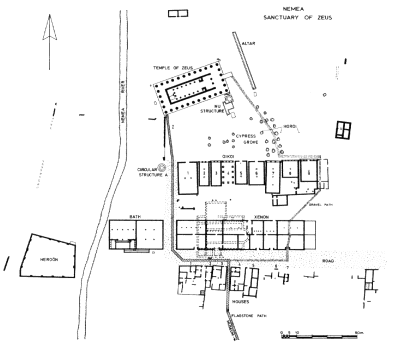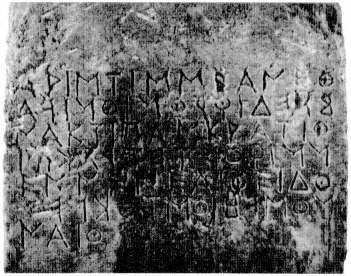Model
In front of the picture window is a model, on a scale of 1:200, of the Sanctuary of Zeus as it would have appeared in about 300 B.C. It is the work of Robert Garbish (compare the plan of the sanctuary, Fig. 10). The flat open squares represent areas not yet excavated. Buildings numbered 1-8 represent the first 8 oikoi (see p. 118 for the various meanings of this word) erected by various city-states for the use of their citizens and guests at Nemea (see pp. 62-63, 67-71, 117-27, 160-68). Numbers 9 and 10 are the Temple and Altar of Zeus, respectively, whereas 11 and 13 represent buildings the precise nature of which has not been established. Number 12 refers to the Epipola with its Sacred Grove of cypress trees and other altars and monuments. The Dining Establishment (14) is attached to some of the oikoi but also clearly differs from them. The number 15 marks an area of light industry (see case 20, p. 63) and a series of wells (see case 9, p. 39). The hotel, or Xenon, is 16 and the Bath 17. The Nemea River is marked 18, and to the west of it

Fig. 10.
Plan of the Sanctuary of Zeus with the walk indicated.
is the hero shrine, or Heroön (19). The region labeled 20 contains a number of houses, probably for the priests or the judges of the Nemean Games.
In the view from the window, the houses (20) are in the immediate foreground, just beyond the edge of the grass. The highest and most massive remains beyond them, consisting largely of gray stones, are of the Early Christian Basilica which lies over the Xenon (16). To the right, or east, of the Basilica the wall of the Xenon comes out from under the church and continues eastward. Finally, the columns of the Temple of Zeus (9) are clearly visible in the background.
Near the model of the sanctuary is a MODEL OF THE STADIUM . Its orientation to and distance from the sanctuary are
proportionally correct, although it is in fact higher in elevation. Indeed, the side of the Evangelistria Hill into which the Stadium was built is visible from the sanctuary model through the window above and behind the Stadium model.
On the wall to the right of the picture window are two groups of color representations of the various events in the ancient games. These have already been described (pp. 4-5).
Below them is a STARTING BLOCK with a single groove for the toes of the runner (A 100). It was probably used originally in the early stadium of the 6th century B.C. , which has not yet been discovered, although it must have been near the Temple of Zeus.[25] As can be seen in the photograph on the wall above, the block was reused as a threshold in a door of the Xenon (cf. p. 169). Beside this starting block is a BLOCK OF HARD GRAY LIMESTONE on the upper surface of which is carved a small groove for a single foot (A 215). Like similarly grooved blocks found in Corinth, this one is from a starting line. A vertical socket at one end of it received a post marking the division of lanes; a lambda (L ) inscribed in front of the socket marks this as the twelfth lane. This block cannot be from the Stadium and so might be from some other race course, perhaps that of the gymnasion . Two more of these blocks are in the foundations of an Early Christian basilica on the crest of Evangelistria Hill.
On the north wall above and to the right is an AERIAL PHOTOGRAPH of the Stadium as it appeared in 1980 (see Fig. 61), with the main features—starting line, water channel, judges' stand, and tunnel entrance—marked out.
On the CENTER ISLAND opposite the aerial photograph of the Stadium is a pair of the terracotta water pipes which brought fresh drinking water into the Stadium (TC 40 and 41). The joints of these pipes, which date from the late 4th century B.C. , were originally sealed with a white clay mortar, in-
[25] See D. G. Romano, "The Early Stadium at Nemea," Hesperia 46 (1977) 27-31.
dicating that water may have come into the Stadium under pressure. Two photographs on the panel above the pipes show them in the Stadium during their excavation.
The other (southern) side of the center island exhibits two terracotta water channels (TC 107 and 83) and an amphora (P 320) which was reused in the entrance passageway to the Stadium as a settling basin, as can be seen in the photograph on the panel above. Water ran into the amphora through "windows" cut in its sides, allowing dirt and debris to settle out before the water continued its journey. This channel is discussed further on page 175. Also on the panel above are detailed photographs of two artifacts in case 7: a bronze strigil (BR 857), with which an athlete scraped off the sweat, oil, and dirt at the end of his exercise, and a dedicatory plaque (BR 1098).
Further on along the NORTH WALL of the exhibition hall is a fragment of stone from a voussoir of the Stadium tunnel and, in the photograph above, the same stone at the time of discovery, fallen on the floor of the tunnel (I 70). This stone, like so many still in place in the tunnel, bears a scratched graffito. Now incomplete, it originally gave the name of an athlete with the adjective kalos , "beautiful."
A photograph on the wall to the right of I 70 shows the tunnel during excavation. Although the two ends had silted shut, a considerable open space in the center was used as a refuge in the 6th century after Christ (cf. pp. 47, 188-90).
The next photographs show other graffiti in the tunnel. One, I 59, has the verb NIKW , "I win," followed, in a different hand, by the name Telestas. This is probably the Telestas who won the boxing event at Olympia in the boys' category in around 340 B.C.[26]
[26] Pausanias 6.14.4. The date of Telestas's victory is not absolutely precise and depends on the career of Silanion, the sculptor of Telestas's statue at Olympia, cf. L. Moretti, Olympionikai. I vincitori negli antichi agoni Olimpici (Atti della Accademia Nazionale dei Lincei, Memorie , ser. 8, vol. 8, Rome 1957) no. 453.

Fig. 11.
Aristis stele (I 4).
The other graffito, I 63 (see Fig. 66), has AKPOTATOS KAL OS , "Akrotatos is beautiful," followed, in a different hand, by TOY G PAY ANTOS , "to the one who wrote it." Akrotatos is almost certainly the Spartan prince who was king from about 265 to 252 B.C. , well known for his physical beauty and his penchant for "Persian luxuries."[27]
At the base of the wall below the photographs just mentioned are TWO BLACK MARBLE STATUE BASES from the Stadium. ST 126 preserves the outline of a left foot, which would have been leaded in place. ST 260 preserves the lead which held its statue in place: the statue had two projections from the sole of each foot rather than the outline of the foot itself. Given the location of these bases near the starting line of the
[27] Plutarch, Agis 3.4 and Pyrrhus 26.8, 28.2-3; Pausanias 3.6.6; Phylarchus apud Athenaeus 4.142b. The precise grammatical significance of this graffito has generated considerable interest; see Bibliography, p. 202.
Stadium, they may well have held statues of victorious athletes and should be dated to around 300 B.C. .
Between the two black marble bases stands a relatively tall LIMESTONE PILLAR (I 4), the top of which has two square cuttings, each with smaller sockets within (the right one still has some lead in place). These would have held a statue, but one of a much earlier date than those mentioned in the preceding paragraph. On the face of the pillar (Fig. 11) is a very early Greek inscription with curious letter forms whose lines read alternately from left to right and right to left. (This style of writing, from a time when the Greek language had not yet settled into a standard written form, is called boustrophedon , from the turning of the oxen at the end of each plowed furrow in a field.) The stone speaks: "Aristis dedicated me to Zeus, the son of Kronos, the king having won the pankration four times at Nemea. (Aristis) the son of Pheidon of Kleonai." The forms of the letters indicate that it was around 550 B.C. that this local boy did very well in the Nemean Games over a period of at least six years.[28]